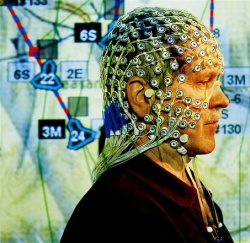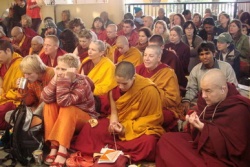Zen's Understanding of Time and Space
Given Zen's seeing as articulated above, one may entertain a natural question: how does Zen understand time and space? Are they significantly different from time and space as conceived by many other theories of time and space? In what follows, we will briefly provide how Zen understands “here and now,” “timelessness and spacelessness,” and “an integrated time and space.”
Here and Now
In spite of, or rather because of the above-mentioned experiential dimension of Zen-seeing, Zen insists that the Zen practitioner plant his or her feet in the everydayness of “here and now.” In this respect, Zen philosophically advocates a position of “not one.” Otherwise, it fears that the practitioner remains in the stillness of meditation, while suspending judgment for action. How then does Zen understand “here and now”? In this connection, one may reasonably ask: “how far and wide is ‘here’ and how long is ‘now,’” when Zen speaks of “here and now.” Are they each limited by a present perceptual experience? In the case of “now,” for example, is it an internal phenomenon of consciousness that allows the practitioner to experience time sometimes as a “memory” (or retention) and some other times as “anticipation” (or “protention”) in the ever flowing stream of “present” (e.g., St. Augustine, Husserl and Merleau-Ponty)? And in the case of “here,” is it delimited by the practitioner's spatial range of perception within the sensory field, situating the Zen practitioner as the point of reference? (There is in both cases a suggestion of involvement of the autonomous activity of the unconscious, of which Zen demands we must stand outside.) Zen's response to both of these questions is a resounding “Yes!” and “No!” however contradictory it may sound. “Yes,” because the practitioner, while living, cannot depart from the “here and now,” because he or she is incarnate, in which case time and space is always experienced as “here and now.” “No,” insofar as the perceptual model implies an ego-logical “human, all too human” stance (Nietzsche) with its attendant limitations, even though Zen does not exclude this model as long as it is not delimited by the dualistic, either-or ego-logical perspective. In the everyday human world that is “here and now,” Zen maintains that “riddhi and [its] wondrous activity all shoulder water and carry firewood” where “riddhi” refers to a power that naturally becomes available to the practitioner through the practice of meditation.
Timelessness and Spacelessness
Yet Zen thinks that the preceding is still a partial understanding of “here and now.” To fully understand it, it is helpful to examine the following often-quoted phrase, as it is particularly illustrative. Zen demands the practitioner “to show one's original face before one's parents were born.” This demand points to an experiential dimension prior to the bifurcation between the subject and the object—and hence “not two”—where “prior” means negation of the spatial-temporal ordering principles such as in Kant's understanding of time and space as a priori forms of intuition. It points to a non-dualistic experiential dimension that is timeless (or zero time) and spaceless (or zero space), by which Zen means that neither time nor space is a delimiting condition for Zen-seeing. In timelessness there is no distinction between past, present and future or between “before” and “after”; in spacelessness there is no distinction between the whole and its parts. One can also say that both time and space, experienced from the point-of-view of the everyday standpoint, is relativized when timelessness temporizes and spacelessness spatializes, where timelessness and spacelessness characterize the bottomless ground. Accordingly, Zen contends that timelessness and spacelessness are the natural and original zone of all things including human beings, for they are all grounded in it. Taking these points together, the Zen enlightenment experience suggests a leap from a causal temporal series.
Consequently, Zen contends that “here and now” is enfolded in both timelessness and spacelessness. This means that one time contains all times and one part contains the whole, as in the case of a holographic dry plate in which a part contains the whole. Seen in this manner, “now” for the Zen person is a temporalization of timelessness, while “here” is equally a spatialization of spacelessness, even though he or she may be anchored in the perceptual field as understood above. In other words, for the Zen person both “now” and “here” are experienced as an expression of thing-events in their suchness, because, as mentioned in the foregoing, Zen takes timelessness and spacelessnes to be the original abode of thing-events. Caution must be exercised here, however. Zen's timelessness should not be confounded with the idea of eternity standing outside a temporal series (e.g., Thomas Aquinas, Newton's “absolute time”) by means of a logical or intellectual transcendence, nor the spacelessness to be identified with “absolute space” (e.g., Newton) wherein there is no content of experience. In other words, Zen does not understand time and space by imposing a formal category on them, by presupposing in advance a form-matter distinction.
An Integrated Time and Space
Zen makes another equally important contention through this abstention, namely that time and space are lived as integrated space-time in the interfusion of a concrete temporalization and spatialization. For example, Dōgen speaks of it as “being-time” (u-ji) to indicate their inseparability; being cannot be apart from time, and time cannot be apart from being, where a being spatializes through the process of temporalization, and where it temporalizes through the process of spatialization. This is a concrete spatialization-temporalization that is lived without any intellectual abstraction, reflecting the Buddhist position that everything, excluding no-thing, is impermanent. Zen abhors an intellectual abstraction that merely thinks time and space. This is because the Zen person rides on the rhythm of living nature. That is, “here and now” is one experience (and hence “not two”), and for this reason they should be designated as “here-now.”
In living this integrated, living space-time, Zen does not understand time to be a quantifiable and homogeneously punctuated unit (i.e., the clock time of natural science), nor does it conceive of it as a linear progression from past to future through the present, although it does not exclude them insofar as they are useful for everyday life. The negation of the linear idea of time also includes the negation of the idea of time as symmetrical as well as reversible, because in the Zen experience of space-time, a teleological intentionality, an “in order that,” is absent. Yet, Zen does not accept, time as a “fleeing image of eternity” (i.e., Plato). Zen takes time to be living. According to Zen, theories of time built through conceptual abstraction, are distanced and separate from the immediacy of “here-now.”
altarSpace, too, is neither a container (i.e., Newtown's “absolute space”) nor an a priori limiting condition (i.e., Kant), nor the place of displacement for the volume of an extended thing (i.e., Aristotle). Rather it is a living space. Dōgen for example captures this sense of space as “the bird flies the sky and the sky flies the bird.” In this statement an independence of both the sky and the bird is recognized, but it also recognizes that the sky and the bird each become themselves only through their interdependence. In other words, what makes this space a living space is the dynamic, interdependent, bilateral play of both bird and sky, from which the living space-time as “here-now” emerges as an ambience, where each of the terms entering the relationship through the activity is granted a full recognition of their being. This is because the Zen person lives the dynamic activity of non-dualistic “coming-together” of “the two,” whether this “two” happens to involve the “betweenness” of two individuals, individual and nature, or individual and trans-individual.
Selected Bibliography
- Abe, Masao. Zen and the Western Thought. Honolulu, Hawai’i: the University of Hawaii Press, 1989.
- Abe, Masao, and Normal Waddell (tr). The Heart of Dōgen's Shōbōgenzō. Albany, New York: SUNY Press, 2002.
- Clearly, Thomas, et al. The Blue Cliff Record. Boulder, Colorado: Shambala Press, 1977.
- Conze, Edward. Buddhist Wisdom Books: The Diamond Sutra/The Heart Sutra. London: George Allen & Unwin, 1972.
- Dumoulin, Heinrich. Zen Buddhism: A History—India and China. New York: Macmillan Publishing Company, 1988.
- –––. Zen Buddhism: A History—Japan. New York: Macmillan Publishing Company, 1990.
- Kasulis, T. P. Zen Action/Zen Person. Honolulu, Hawai’i: the University of Hawaii Press, 1981.
- Heisig, James W. Philosophers of Nothingness. Honolulu: University of Hawai’i, 2001.
- Herrigel, Eugen. Zen in the Art of Archery. New York: Vintage Books, 1971.
- Iriya, Yoshitaka (ed). Rinzai roku [The Records of Zen Master Rinzai]. Tokyo, Iwashami shoten, 1989.
- Nagatomo, Shigenori. “The Logic of the Diamond Sutra: A is not A, Therefore A” in the Journal of Asian Philosophy, vol. 10. No. 3, 2000, pp. 213-244.
- Nishitani, Keiji. Religion and Nothingness. Berkeley: The University of California Press, 1982.
- Sasaki, Ruth Fuller. The Recorded Sayings of Ch'an Master Lin-chi Hui-chao of Chen Prefecture. Kyōto: Institute for Zen Studies, 1975.
- Suzuki, D.T. Essays in Zen Buddhism. New York: Samuel Weiser Inc., 1976. (2nd series)
- –––. Essays in Zen Buddhism. New York: Samuel Weiser Inc., 1976. (3rd series)
- –––. Manual of Zen Buddhism. New York: Grove Press, 1960.
- ––– (tr). The Lankāvatā ra Sūtra. Boulder, Colorado: Prajñā Press, 1932.
- Thurman, Robert (tr). The Holy Teaching of Vimalakīrti (University Park; The Pennsylvania State University, NA).
- Ueda, Shizuteru (ed). Zen no sekai [The World of Zen]. Tokyoz: Risōsha, 1981.
- Yanagita, Seizan. Mu no tankyū; Chūgoku zenbukkyō [Inquiry into Nothing: Chinese Zen Buddhism]. Tokyo: Kadokawa shoten, 1974.
- Yamada, Kōūn. Gateless Gate. Los Angeles: Center Publications, 1979.
- Yampolsky, Philip (tr). The Platform Sutra of the Sixth Patriarch. Columbia: Columbia University Press, 1976.
- Yuasa, Yasuo. “Shinsōshinri no genshōgakunōto” [[[Wikipedia:Phenomenological|Phenomenological]] Notes on Depth-psychology], in Yuasa Yasuo Zenshū [Complete Works of Yuasa Yauso]. Tokyo: Hakua shobō, 2003, vol. 4.
- –––. The Body: An Eastern Mind-Body Theory. Nagatomo Shigenori and Thomas P. Kasulis, tr. Albany, New York: SUNY, 1987.
- –––. The Body, Self-Cultivation and Ki-Energy. Shigenori Nagatomo and Monte S. Hull, tr. Albany, New York: SUNY, 1993.
- Wilson, W.S. (tr). Sōhō Takuan, The Unfettered Mind: Writings of the Zen Master to the Sword Master. New York: Kodansha International, 1986.



